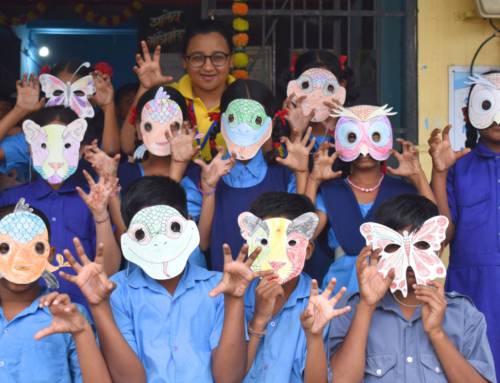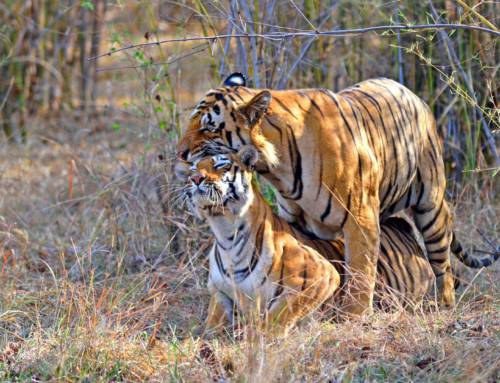Research article: Salazar, G, Satheesh, N, Ramakrishna, I, Monroe, M, Mills, M, Karanth, KK. (2024). Using environmental education to nurture positive human-wildlife interactions in India. Conservation Science and Practice. In the press.
Blog Author: Nitya Satheesh
Highlights:
- Environmental education initiatives are crucial for mitigating human-wildlife conflicts in rural regions.
- In 2018, CWS launched Wild Shaale, an environmental education program aimed at 10-13-year-old students in government schools.
- The research encompassed 43 schools surrounding Bandipur National Park, Nagarahole National Park, Male Mahadeshwara Wildlife Sanctuary, and Cauvery Wildlife Sanctuary in Karnataka.
- 86 schools around Melghat Wildlife Sanctuary, Pench Tiger Reserve, and Tadoba Tiger Reserve in Maharashtra were also a part of it.
- The initiative impacted 4,331 students across both the states.
- Culturally sensitive approaches resonate deeply with communities, boosting engagement and ensuring programs’ significance.
Mitigating conflict between humans and wildlife is essential for the safety of both communities and animals. When conflict arises, it poses a significant danger, risking harm or even fatalities for both people and wildlife. Children, in particular, may find their daily lives disrupted by these conflicts, impacting their ability to attend school or engage in outdoor activities safely. Extensive research by the Centre for Wildlife Studies revealed that children raised in areas with frequent human-wildlife conflicts often develop negative perceptions and limited understanding of wildlife. Environmental education (EE) serves as a crucial tool in addressing conflict by promoting understanding and respect for nature. Through environmental education, children gain the knowledge and skills needed to coexist peacefully with wildlife, thereby reducing negative encounters and enhancing safety for all involved.
In 2018, CWS introduced Wild Shaale, an EE program designed for 10 to 13-year-old students in government schools. Our program’s objectives include enhancing students’ environmental understanding, cultivating positive attitudes towards wildlife, nurturing empathy for animals, and teaching skills for safer coexistence with wildlife. In this study, the authors focus on the third phase of the program conducted between 2019 and 2020, specifically evaluating how participation in the Wild Shaale program impacts children’s environmental knowledge, understanding of safe coexistence behaviors, and attitudes toward wildlife. Additionally, they also outline the program’s scalability and how it is designed for broader implementation. The study was conducted in 43 schools near Bandipur National Park, Nagarhole National Park, Male Mahadeshwara Wildlife Sanctuary, and Cauvery Wildlife Sanctuary in Karnataka. It also included 86 schools near Melghat Wildlife Sanctuary, Pench Tiger Reserve, and Tadoba Tiger Reserve in Maharashtra. In total, the program reached 4,331 students across both states.
Wild Shaale comprises four 2-3 hour modules, implemented weekly in each school. Each module in our program follows the experiential learning model, a four-step framework where learners: experience, reflect, connect, and apply their new knowledge. The program curriculum blends classroom-based education with outdoor activities, including nature walks and outdoor games in the schoolyard. For on-ground program implementation, we hired and trained teams from the regions where the program was implemented. These staff members had diverse backgrounds in wildlife biology, ecology, education, arts, and chemistry. Before the third phase, 26 staff participated in a 4-day training in Bengaluru, where they learned about experiential learning, best practices in EE, and evaluation.
We assessed the program using a pre-post model, where students took a test before starting the program and a very similar test after completing it. Students from both states exhibited a statistically significant increase in environmental knowledge and a greater number of students listed environmentally safe behaviors in the post-test. Baseline attitude questions showed positive attitudes towards wildlife, which was enhanced by their participation in our program. Responses from both states indicated an appreciation for tigers and an interest in learning more about wildlife. Additionally, some students expressed intentions to change behaviors, such as grazing livestock in the forest. The findings from the study indicate a notable improvement in local environmental awareness, safe behavior knowledge, and certain aspects of environmental attitudes among participants following their involvement in the program.
The evaluation suggests the program is achieving its goals, but some limitations should be noted. Firstly, no control or comparison group was used. Secondly, unclear handwriting led to data loss in open-ended questions, and potentially biased results, and lastly positive increases in knowledge and attitudes may also be influenced by students’ desire to please the Wild Shaale educator.
Recommendations from the authors include considering oral interviews for equal participation to develop culturally sensitive EE programs with innovative activities led by trained staff, emphasizing NGO leadership in regions with limited teacher training and school resources, and conducting more research on adapting such programs and evaluations to the diverse contexts of HWC in rural areas of developing countries. This will enable the creation of tailored programs that effectively address the specific challenges faced in each region.
Despite the challenges faced, the Wild Shaale program has proven to be a scalable model that resulted in positive increases in local environmental knowledge, understanding of conflict avoidance behaviors, and certain aspects of environmental attitudes.
To access the original article, click here
Keywords: Coexistence, conservation education, environmental education, human-wildlife conflict, India, Western Ghats



